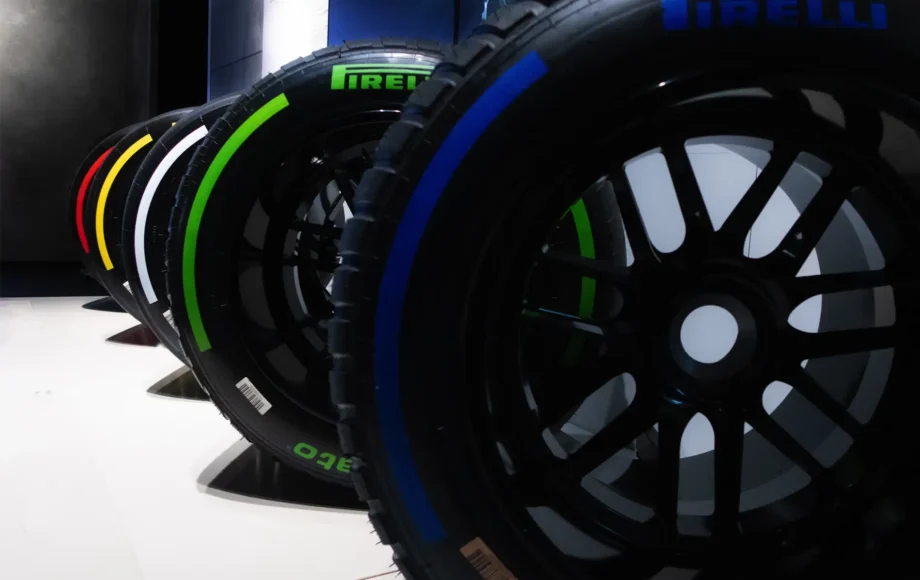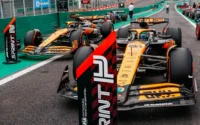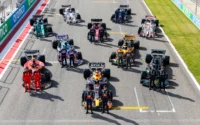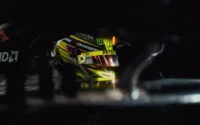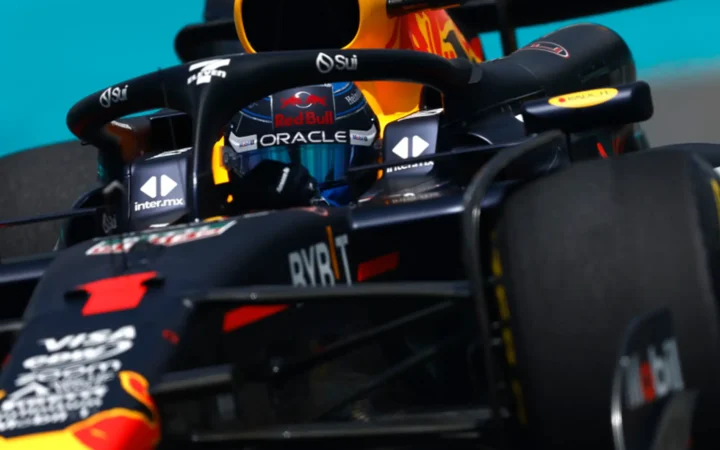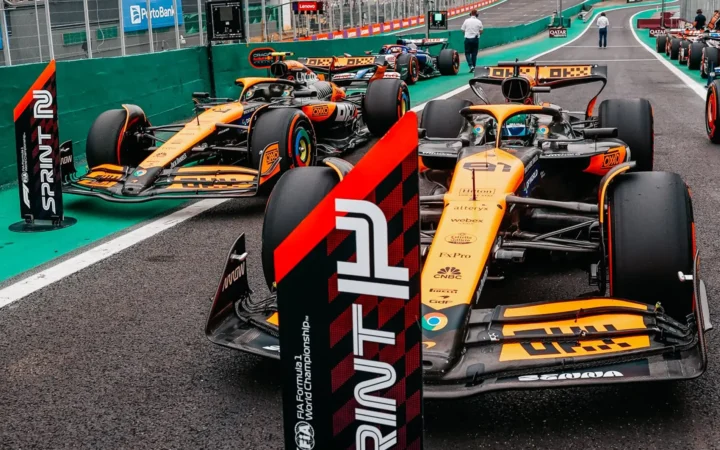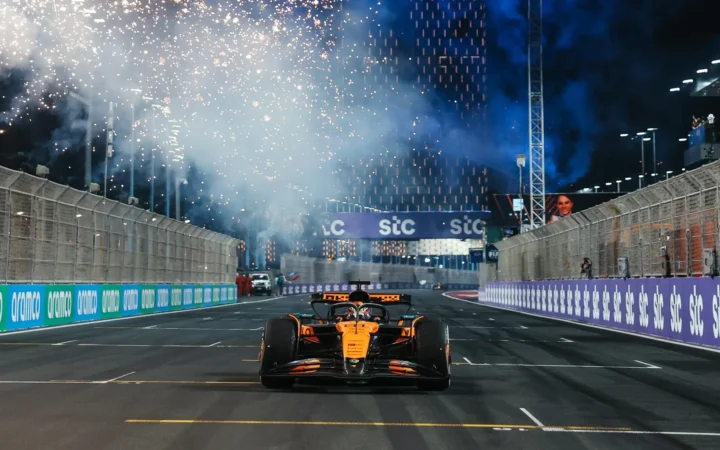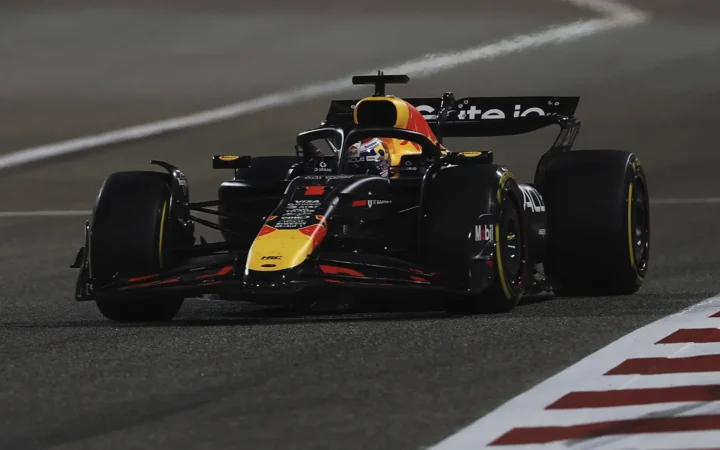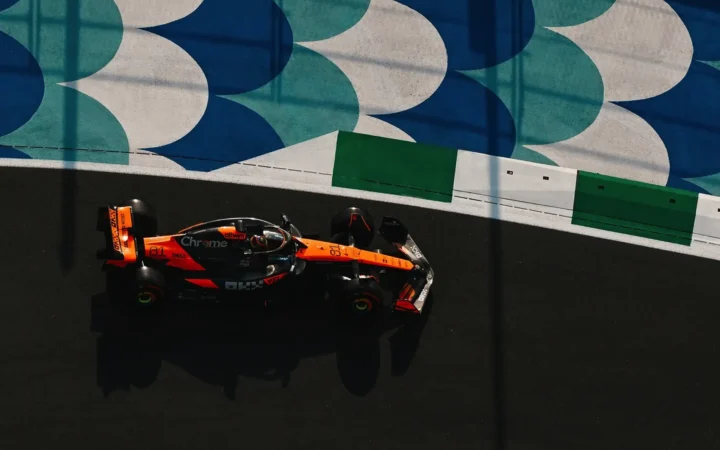Featuring

From engines to aerodynamic design, every part of an F1 car plays a pivotal role in the outcome of a race alongside the driver. Tyres are among these race-changers.
What to know
- Pirelli, an Italian tyre manufacturer with a rich motorsport heritage, has been the exclusive tyre supplier since 2011.
- Pirelli’s range of tyres comprises slick compounds from hardest to softest, along with intermediates and full wets.
- During the race, drivers must use at least two different dry compound sets, unless wet conditions dictate otherwise.
- Formula 1 Teams participate in tyre testing sessions conducted by Pirelli to develop and improve tyre compounds.
Since the first race in 1950, tyres have played a significant role in F1 history. In this guide, we’ll explore who supplies the gird, the current spec of F1 tyres, the compounds used at each track, and the rules and regulations that govern how teams can use them during a race weekend.
Who supplies F1 Teams with tyres?
For decades, Pirelli, an Italian tyre manufacturer, has been a name linked to F1. With a rich history in motorsport across various race series, including Formula 1, Pirelli became the exclusive supplier to F1 in 2011. They work with the teams on tyre development, research, and testing, as well as Formula 1 and the FIA to provide a wide range of tyres. These tyres must work across various track conditions, from smooth to abrasive surfaces to weather-dependent races and car setups.
In 2022, Pirelli made a major change under the rules set by the FIA in the type of tyres used to meet one of the biggest rule changes the F1 has ever made. Instead of supplying 13-inch tyres, the FIA moved to 18-inch tyres in a bid to change the cars’ performance and handling. The larger, wider tyres provided several advantages in terms of performance and safety but also helped F1 align more with the tyres used in high-performance road cars.
F1 tyre jargon explained
With lots of terms used for F1 tyres, before we jump in, let’s cover some jargon:
Scrubbed: When a tyre is referred to as “scrubbed,” it means that it has been used in a session or race and has worn down its outer layer. Scrubbed tyres are no longer in a new condition and may have slightly reduced performance compared to brand-new tyres.
Slicks: Slick tyres have no tread pattern or grooves. They are used on dry tracks to maximise grip and performance, making them ideal for races in dry conditions.
Compound: A tyre compound refers to the specific blend of rubber used in the tyre’s construction.
Blistering: Blistering happens when the surface of a tyre overheats, and rubber bubbles or blisters form on the tyre’s surface. Excessive friction causes it, leading to a loss of grip and tyre performance.
Graining: Graining is a term used when a tyre’s surface wears unevenly, resulting in a rough, grainy texture. It tends to happen in cooler conditions or when a tyre compound doesn’t reach its optimal operating temperature. Graining leaves rubber particles on the surface of the tyre, reducing the grip and can affect a car’s handling.
Flat Spot: A flat spot is a localised area of a tyre that becomes flat due to heavy braking or a lock-up. When a tyre skids without rotating, it can create a flat spot on its surface. Flat spots cause vibrations, causing performance issues and affecting the comfort of the driver.
Deg: “Deg” is shorthand for tyre degradation. Degradation is the gradual wearing down of a tyre’s rubber as it is used during a race. Think of it like a road tyre where your tread wears away over time. Teams will monitor tyre deg to decide when to make pit stops and switch to fresh rubber.
Specification of F1 tyres
Pirelli’s range of 18-inch tyres offers six slick compounds (from hardest to softest: the C0, C1, C2, C3, C4, and C5), along with intermediates and full wets for wet weather conditions.
With wider wheels, this has created a larger contact area on the track, offering drivers more grip and allowing cars to corner at higher speeds and brake more effectively.
The 18-inch design has also been designed to give F1 teams a more predictable tyre for race strategy and make it easier for drivers to control during the race.
Like most of the technology you see in an F1 car, it has, at some point, made its way into a road car. Formula 1 is a testbed for automotive tech, from hybrid technology to suspension and automatic transmissions. The move to 18-inch tyres aligns Formula 1 more closely with the tyre sizes used in high-performance road cars and will surely provide Pirelli with insights and technology they can apply to their road-going tyres.
Pirelli’s slick compounds
Pirelli’s range of 18-inch tyres consists of six slick compounds, each with unique characteristics. These compounds are designated from hardest to softest as the C0, C1, C2, C3, C4, and C5.
Pirelli will bring three of these tyres to a race, depending on the track, using a sliding scale. For example, they might choose C3, C4 and C5. In that case, the C3 will be classified as the hardest compound for the weekend. Similarly, on another weekend, it might be the C0, C1, and C3. In that case, the C3 will be classified as the softest compound for the weekend.
These are then colour-coded with red (soft), yellow (medium), and white (hard) paint on the tyre’s wall.
C0 – The hardest compound
The C0 compound is the hardest in Pirelli’s lineup. Great for tracks that feature abrasive surfaces or when teams are looking to maximise tyre life during a race, it may sacrifice some outright grip, but it offers durability over long stints, which can be valuable when a driver has been hit with penalties. It allows teams to make a strategic offset to other teams around them, playing with a one-stop race over maybe a two or even a three-stop race.
C1
The C1 compound is the next step softer than the C0. Proving a balance between grip and durability is often used on tracks where tyre wear is a concern, but the grip is still important.
C2
This tyre begins to get softer and offers a bit more grip at the expense of some durability. Ideal for races where teams expect to make multiple pit stops or where performance is a higher priority than tyre life.
C3
The C3 compound is a common choice for many races. It sits in the middle of offering the balance between grip and longevity, and is used at a wide range of tracks during the seasons calendar.
C4
One of the softer compounds, the C4 offers even more grip. It’s generally used when the track conditions demand maximum performance and teams are willing to trade off durability for higher speeds.
C5 – The softest compound
The C5 compound is Pirelli’s softest and stickiest. It is designed for maximum grip and performance, making it the preferred choice for short, high-speed circuits with smooth surfaces.
Intermediate and Wet tyres
In addition to the slick compounds, Pirelli has to deal with inclement weather conditions. When the slicks don’t cut it, Pirelli has the intermediate and full wet tyres to fall back on. These tyres are designed to maintain a level of safety and control for the drivers when they are driving in the rain or over standing water.
Intermediates
Intermediate tyres have a distinctive tread pattern that provides grip on wet but not fully soaked tracks. They allow drivers to maintain more control and confidence over using slicks versus losing performance if they picked a full-wet tyre.
Full Wet Tyres
Full-wet tyres are the go-to choice when the track is soaked, and there is a lot of standing water or even rivers of water in sections of the track. These tyres boast deep grooves that channel water away from the tyre surface to prevent aquaplaning and give the driver better control in heavy rain.
How many tyres can an F1 driver use over an F1 weekend?
Each driver is allocated a set number of tyres for a race weekend. These tyres are divided into dry slick tyres and wet weather tyres (intermediates and full wets).
The total number of tyres available to a driver for a race weekend can vary depending on the specific race and the conditions at the track.
Dry Slick Tyres
For the dry, slick tyres, which are used in normal race conditions when the track is dry, the allocation generally includes thirteen sets of slick tyres.
As mentioned already, Pirelli will decide what to bring to a race, depending on the track, using a sliding scale from C0 to C5.
The allocation will include a predetermined number of soft, medium, and hard compound tyres, and the number of sets for each compound will vary depending on the race and the expected weather conditions. For example, there might be more soft tyres available than hard ones, but they aren’t always equally distributed.
Wet Weather Tyres
Drivers are allocated a specific number of wet weather tyres. Generally, there will be four sets of intermediate tyres for when the track is damp or drying and three sets of full wet tyres when there is heavy rain and standing water on the track
Utilising the allocations
Managing these allocated sets of tyres over a race weekend from the first free practice to the end of the race is down to the teams. As Pirelli and Formula 1 decide which tyres are supplied to them, teams have to plan their tyre strategy carefully to optimise performance during practice, qualifying, and the race itself.
Free practice sessions
There are three practice sessions (unless there is a Sprint Race) over a race weekend. During free practice sessions on Friday and Saturday, teams have a degree of flexibility in using their allocated tyres, but this will impact what they have from the fresh sets available for quali and the race.
Qualifying
Similarly, in qualifying, teams can choose the compounds they want to use from their remaining allocation. Once again, this choice can impact the car’s performance in the race, but it can also determine where a driver lines up on the grid. Generally, if a driver gets to the final Q3 session in qualifying, the pole sitter will have used a set of soft to set the fastest time. If a driver or team opts for a medium set, they will unlikely feature higher up the grid. But it will give them an extra set of fresh softs in the race, which could be an advantage come race day.
More on F1 Qualifying
The race
During the race, drivers must use at least two different slick compounds unless wet weather dictates otherwise. This rule adds a strategic edge to the race and excitement for fans by spicing up the race. Teams must decide when to switch to different compounds and how long to keep a driver out on a set of tyres to prolong their stint and hopefully have fresher tyres later in the race. Sometimes, teams might opt for a one-stop, two-stop or even three-stop; this variation adds variety up and down the grid and can offset teams against each other on the track, adding another layer of excitement for fans.
Can F1 drivers share tyres?
Each driver is allocated a governed number of tyre sets for a race weekend, exclusively for their use. Therefore, drivers cannot exchange or share tyres with their teammates or competitors. There is no leniency to this rule. A notable incident featured at the 2020 Bahrain Grand Prix, George Russell was inadvertently provided with his teammate Valtteri Bottas’s tyres when both Mercedes drivers made back-to-back pit stops. As a result, the team was fined €20,000. Stewards opted to give Mercedes a fine – rather than disqualification.
Tyre strategy
Nailing the right tyre strategy can be the difference between winning and losing a race. It involves a combination of analysis, simulation work back at the factory, and real-time decision-making during the race weekend.
Teams begin by analysing the characteristics of the track before they arrive there. They have historical data from previous years and updates on the changes made over the winter break. That might include a resurfacing or a layout change. They’ll factor all this in alongside the track’s surface abrasiveness, corner types (high-speed, low-speed, hairpins), and the length of straights. Teams can put this data into simulation work, and it will help teams decide which compounds are going to perform best.
Weather also plays a massive role in tyre strategy. Teams closely monitor weather forecasts for the entire race weekend with radar. Rain or changing weather conditions can alter tyre choice, and teams may even swap out a well-planned strategy and use a different slick compound mid-race if conditions change dramatically.
All the best predictions don’t make up for real-world data on tyre performance. The three practice sessions are for that. The data in these sessions will fine-tune a team’s strategy and give them a chance to change their ideas where predicted data doesn’t match the real world.
Once a race starts, teams will have the final number of tyres available to them, from scrubbed to fresh. Tyre strategy remains fluid throughout. Teams will continually monitor tyre degradation and track conditions. Safety Cars, punctures, damage, and weather, as well as real-time data and feedback from the drivers, mean teams have to make on-the-fly decisions regarding pit stops and tyre changes at a split-second notice.
Pit stops are the pivotal moments in a race when the strategist’s teams know if their race is going in the right direction. Teams decide when to bring a car in for fresh tyres based on tyre degradation, lap times, and the gap to competitors. These decisions maximise a car’s time on faster, fresher tyres while minimising the time lost in the pits.
After the race, teams will have a race debrief at the track and back at the factory. They review data, lap times, and performance to assess the effectiveness of their decisions. This will inform of future strategies at similar tracks or conditions.
Other tyre rules to remember
In addition to tyre compounds and supplier arrangements, Formula 1 has regulations governing tyre usage during a race weekend.
- Mandatory Tyre Changes: F1 Teams are usually required to make at least one pit stop during a dry race. This rule ensures that teams do not attempt to run an entire race on a single set of tyres, which could compromise safety and strategy.
- Tyre Blankets: To maintain tyre temperatures, teams use tyre blankets before fitting fresh rubber during pit stops. However, this regulation could change in the future, with no blankets to be used at all.
- Tyre Pressure and Temperature: Tyre pressure and temperature play a crucial role in tyre performance. Teams closely monitor and adjust these parameters to optimise grip and handling.
- Tyre Testing: Formula 1 Teams participate in tyre testing sessions conducted by Pirelli to develop and improve tyre compounds throughout the season and after. This collaborative effort makes sure that the tyres evolve to meet the demands of modern F1 cars.
- Tyre Safety: Safety is a top priority in F1, and tyre-related incidents are taken seriously. If a tyre punctures or experiences excessive wear, it can lead to dangerous situations. Pirelli and race stewards will investigate any concerning, multiple, or strange incidents to see if there are solutions to prevent them from happening again.
Seen in:

